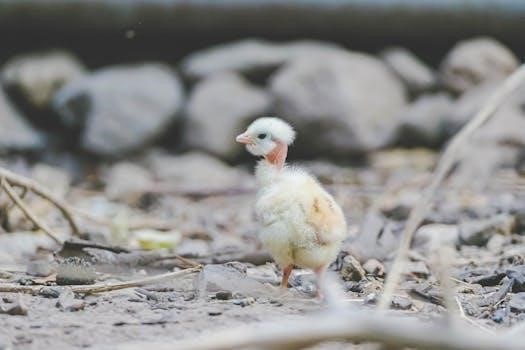
The study of chick embryo development offers a fascinating look into the intricate processes of life. This process, from a single fertilized cell to a fully formed chick, involves a series of well-defined stages and remarkable transformations over approximately 21 days of incubation.
Overview of Chick Embryo Development
The development of a chick embryo is a complex and precisely orchestrated sequence of events. It begins with the fertilization of the ovum and progresses through various stages of cell division, differentiation, and organogenesis. Initially, the single-celled zygote undergoes rapid cleavage, leading to the formation of the blastodisc. This structure further develops into the area pellucida and area opaca, setting the stage for gastrulation. Gastrulation involves the formation of the primitive streak, a crucial step that establishes the three germ layers⁚ ectoderm, mesoderm, and endoderm. These layers are the foundation for all tissues and organs. Subsequent development involves the formation of the neural tube, heart, somites, and the establishment of the circulatory system. The embryo’s growth continues with limb bud development, feather formation, and the development of specialized extraembryonic membranes like the chorioallantoic membrane, which is crucial for gas exchange and calcium absorption. Finally, pre-hatch metabolic changes prepare the chick for hatching and its post-hatch life.

Early Stages of Chick Embryo Development
The initial phase of chick embryogenesis encompasses fertilization, cell division, and the establishment of the basic body plan. These critical steps lay the foundation for all subsequent development.
Fertilization and Initial Cell Division
Fertilization in the chick embryo occurs within the infundibulum of the hen’s oviduct, approximately 15 minutes after the follicle releases the yolk. Following fertilization, the zygote embarks on a series of rapid cell divisions, known as cleavage. These initial divisions, which begin roughly five hours post-fertilization, are crucial for establishing the cellular foundation of the developing embryo. The cleavage process continues as the egg travels along the oviduct, resulting in a multicellular structure. This stage is characterized by rapid cell proliferation without significant overall growth in size. This early phase sets the stage for the complex developmental events that will follow, laying the groundwork for the formation of the blastodisc and the subsequent stages of embryonic development. The divisions are crucial for creating the building blocks of the future chick.
Formation of the Blastodisc, Area Pellucida, and Area Opaca
Following the initial cell divisions, the developing embryo forms a blastodisc, a disc-shaped layer of cells situated atop the yolk. This blastodisc is not uniform in appearance; rather, it differentiates into two distinct regions⁚ the area pellucida and the area opaca; The area pellucida, a lighter, translucent central region, is the primary location where the embryo will develop. It is surrounded by the area opaca, a denser, more opaque peripheral region. This differentiation is visible about four hours after incubation begins. The area opaca does not directly contribute to the embryo’s body but plays a supportive role. The distinction between these two areas is crucial for the subsequent developmental processes, marking the start of more complex organizational changes within the embryo. The area pellucida is essential for the development of the embryo proper.
Primitive Streak Formation and Gastrulation
Gastrulation, a pivotal event in embryonic development, is marked by the formation of the primitive streak. This elongated structure appears within the area pellucida and establishes the embryo’s basic body axes. Cells from the epiblast, the outer layer of the blastodisc, migrate towards the primitive streak and involute, moving inward to form new germ layers—the endoderm and the mesoderm. The remaining epiblast cells become the ectoderm. This process of cellular rearrangement leads to the formation of a three-layered embryo. Gastrulation is a dynamic phase, involving extensive cell movements and signaling interactions. The primitive streak acts as an organizing center, essential for the establishment of the basic body plan, and the formation of these germ layers is fundamental for the subsequent organogenesis. This marks a significant shift from a simple cellular arrangement to a more complex and organized embryonic structure.

Organogenesis and Key Structure Development
Following gastrulation, organogenesis begins, with the formation of key structures such as the neural tube, heart, and somites. This is a period of rapid differentiation and tissue development.
Neural Tube Development and Formation
The formation of the neural tube marks a pivotal moment in chick embryo development. Arising from the ectoderm, the neural plate folds inward, creating a groove which then closes to form the neural tube. This structure is the precursor to the central nervous system. This process is initiated after gastrulation, around the 20-22 hour mark, and involves precise cellular movements and molecular signaling. The notochord, derived from the mesoderm, plays a crucial role, signaling the ectoderm to form the neural plate. As the neural tube closes, the cells on the crest of the fold will give rise to the peripheral nervous system. The spinal cord and brain develop from different regions of the neural tube. The neural tube development is essential for the formation of the nervous system.
Heart Development and the Circulatory System
Heart development in the chick embryo is a complex process, beginning very early in development. Cardiac progenitor cells in the epiblast start to form the heart around stage HH 3. The heart develops from the splanchnic mesoderm, with the primary and secondary heart fields contributing significantly to its formation. The heart starts as a simple tube which then folds and septates to form the four-chambered heart. Simultaneously, the circulatory system begins to develop, with the vitelline system extending into the yolk for nutrient absorption. By the end of the third day, the heart is visibly beating and the embryonic and vitelline circulatory systems are well-established. The development of the heart and circulatory system is vital for nutrient and oxygen transport, necessary for further development.
Somite Formation and Early Body Plan
Somite formation is a crucial process in establishing the early body plan of the chick embryo. Somites are blocks of mesoderm that form sequentially along the developing neural tube. These somites give rise to important structures, including the vertebrae, ribs, and skeletal muscles. The process begins with the segmentation of the paraxial mesoderm, and the number and pattern of somites are very specific to the species. The formation of somites is essential for defining the segmented structure of the embryo. Furthermore, the somites contribute to the formation of the dermis of the skin. This segmentation is a very important step in the development of the overall body plan. The early body axis is defined by the notochord and somites help organize the embryo.

Late Stages of Chick Embryo Development
As the chick embryo matures, significant developments occur, including limb growth, feather formation, and vital membrane functions. These late stages prepare the embryo for hatching and life outside the egg.
Limb Bud Development and Growth
During the late stages of chick embryo development, limb buds undergo rapid growth and differentiation. These buds, which initially appear as small protrusions, gradually develop into wings and legs. This process involves complex interactions between various cell types and signaling pathways. The limb buds start as masses of mesenchyme covered by ectoderm, and as they grow, they elongate and flatten. The formation of cartilage and bone within the limbs leads to the development of distinct skeletal structures. As development continues, the digits of the limbs form, initially as cartilaginous condensations which are then ossified, and muscles and tendons attach for movement. This entire process is precisely regulated to ensure the correct shape and function of the limbs, which are crucial for the chick’s survival after hatching.
Development of Feathers and Other External Features
The late stages of chick embryo development are marked by the emergence of feathers and other external features. Feather development begins with the formation of feather germs, which are small epidermal thickenings that give rise to feather follicles. These follicles then grow and differentiate into the various types of feathers, such as down feathers and contour feathers. The process involves complex interactions between the epidermis and the underlying dermis, with specific signaling pathways regulating the growth and patterning of feathers. Simultaneously, other external features, such as the beak and claws, undergo significant development. The beak begins to harden and an egg tooth develops, which will be crucial for hatching. The toenails become visible and also begin to harden. These changes prepare the chick for life outside the egg.
Chorio-Allantoic Membrane Function and Development
The chorio-allantoic membrane (CAM) is a crucial structure for chick embryo development, formed by the fusion of the chorion and allantois. Its primary function is to facilitate gas exchange between the embryo and the external environment, allowing the embryo to obtain oxygen and release carbon dioxide. The CAM also plays a significant role in calcium absorption from the eggshell, which is essential for skeletal development. Blood vessels within the CAM transport these vital resources to and from the developing embryo. This membrane expands rapidly during development, eventually lining the inner surface of the eggshell. It remains attached to the eggshell after hatching and is critical for the later stages of embryonic development.

Hatching and Post-Hatch Development
The culmination of embryonic development is hatching, a complex process involving pre-hatch metabolic shifts and the chick’s emergence from the egg. Post-hatch development continues with the chick growing and maturing.
Pre-Hatch Metabolic Changes
Significant shifts in metabolism occur in the late stages of chick embryo development, preparing it for hatching and life outside the egg. These changes include alterations in energy requirements and muscle protein dynamics. As the embryo nears hatching, there is an increased need for energy to support the final stages of development and the physical demands of pipping and emergence. This leads to changes in the way the embryo utilizes resources, including shifts in glucose metabolism and the breakdown of stored proteins. Furthermore, muscle protein degradation can occur, which, if excessive, can compromise the chick’s initial post-hatch development. Pre-hatch metabolic adjustments are crucial for a successful transition to independent life. The embryo prepares for external respiration and thermoregulation, readying itself for the challenges of its new environment.
Hatching Process and Emergence
The hatching process is a critical culmination of embryonic development, involving a complex sequence of events leading to the chick’s emergence from the egg. The chick initiates hatching by pipping, using its egg tooth to create a small hole in the shell. This allows the chick to access external air and begin pulmonary respiration. The chick then continues to chip away at the shell, rotating within the egg to weaken it further. This process can take several hours, during which the chick is transitioning from its embryonic environment to the outside world. Finally, the chick pushes its way out of the shell, completing its journey from embryo to independent hatchling. The chorio-allantoic membrane, essential for gas exchange during development, remains attached to the eggshell after the chick emerges.
Post-Hatch Chick Development
Post-hatch chick development marks the beginning of a new phase in the life cycle, characterized by rapid growth and maturation. Immediately after hatching, chicks are dependent on the yolk sac for nutrition, but they quickly begin to consume external food. The first few days are critical for establishing the chick’s immune system and developing thermoregulation. The chick’s body weight increases significantly during this period, and feathers develop rapidly, providing insulation. The digestive system also adapts to process solid food. Chicks become more mobile and begin to explore their surroundings. Their behavior changes from a primarily passive existence within the egg to active engagement with the environment. This period is crucial for the overall health and future productivity of the chicken.



